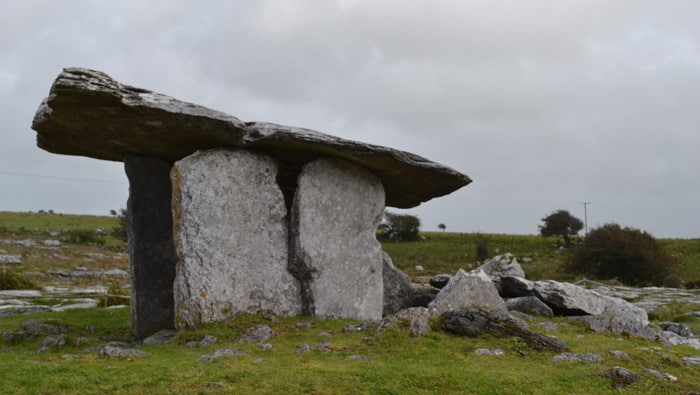Within the stark landscape limestone desert of the Burren in Co. Clare you will find the Poulnabrone Dolmen.
The Hole of the Quernstone
The name Poulnabrone translates from Gaelic, Poll na mBrón, as “Hole of the Quernstone”. It can sometimes be seen in literature wrongly translated as “Hole of Sorrows”.
This particular Dolmen, or more correctly, Portal Tomb is situated in the centre of a low round cairn and is one of the most photographed megalithic monuments in Ireland.
It is also one of the most visited with tour buses arriving regularly all year round.
It is best to arrive early in the day otherwise you are most likely to find quite a few sightseers around.
There are close on 200 Dolmen’s scattered around Ireland mainly in Co. Clare, Co. Waterford and the northern part of the country.
From Irish folklore they are often known as “Diarmuid and Gráinne’s Bed”, in Gaelic “Leaba Dhiarmada agus Ghráinne”, from the legend of the elopement of Diarmuid and Gráinne, the wife of Fionn Mac Cumhaill.
Characteristics of the Poulnabrone Dolmen
The main characteristic feature of a Dolmen is the massive roof stone, known as the Capstone.
This usually weighs many tons and is inclined at an angle with the highest part over the entrance.
This one measures approximately 12ft by 7ft (3.7m by 2.1m) with the chamber being approximately 8ft by 4ft (2.4m by 1.2m) in size.
The entrance is known as the Portal and is often closed by a blocking stone, the “sill-stone”.
Interestingly, Poulnabrone Dolmen is not located, like many portal tombs, adjacent to a waterway.
Instead it is adjacent to a road that in the past may have been an ancient north-south route through the Burren.
This is likely as it was one of only three viable north-south routes through the area.
Situated as it is on the high open plateau the monument may have been used to broadcast a message of territorial ownership to outsiders travelling through the area.
Archeological Excavations
Radiocarbon dating places its construction and use to between 3,800 and 3,200 BC during the Neolithic period.
The site was excavated by Dr. Anne Lynch of Duchas in 1986 and 1988.
The initial work mainly concentrated in the chamber of the tomb.

Further excavations were carried out during 1988.
During the excavations, the remains of up to 22 people were discovered, 16 adults and 6 children were found within the chamber area.
The remains were found 9.8 in (25 cms) below the surface placed in the grykes (crevices) in a disarticulated state.
This would imply the bodies had been ‘kept’ elsewhere and then moved to the dolmen for final burial.
None showed evidence of cremation although there was scorch marks on some bones.
Research has shown that most died before reaching 30 with only one living beyond 40.
Arthritis was in evidence and at least one may have died from being wounded as the tip of an arrowhead was found embedded in his hip bone.
Results published during June 2020 from the genome survey led by Trinity College Dublin unearthed some unexpected results according to the National Monuments Service, with the discovery of the earliest yet diagnosed case of Down Syndrome in one of the male children buried there.
Isotope analyses of this child by Trinity College Dublin showed a dietary signature of breastfeeding.
In combination with being afforded burial in the chamber, an honour afforded to very few, the researchers suggest this provides an indication of care and that visible difference was no barrier to prestige burial.
Along with the human bones animal bones were found as well as a variety of artefacts. This included a stone axe, arrowheads, beads, a bone pendant, quartz crystals and several bits of pottery.
These artefacts can be viewed by visiting Clare Museum, Ennis, Co. Clare.
Restoration Works at Poulnabrone Dolmen
The excavation work was prompted so as to allow repairs to be carried out to a cracked eastern portal stone which looked as if it was about to give way.
Restoration works on the Dolmen were completed by adding a new orthostat on the western side of the chamber to help spread the load of the Capstone more evenly.
The southwestern chamber orthostat was also straightened, previously it had broken in antiquity and was leaning inwards.
Directions to the Poulnabrone Dolmen
- Poulnabrone is near Ballyvaughin, on the Corofin – Ballyvaughan Road.
- To locate it, travel through Corofin on the R476 until you reach the road junction at Leamaneh Castle.
- Turn right onto the R480 and you will find the Dolmen signposted on the right about 9 kilometers up this road towards Ballyvaughan.